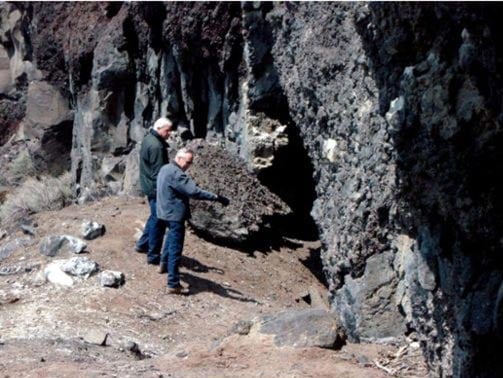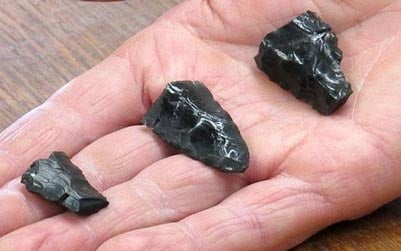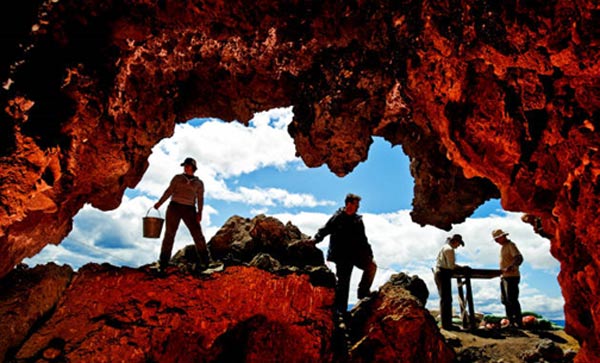Ancient Oregon caves may change understanding of human habitation in Americas
A network of caves in rural Oregon, known as the Paisley caves, may contain archaeological evidence of the oldest definitively-dated human presence in North America, according to a Reuters news release. The site was first studied in the 1930s, but new scientific excavations and analyses have uncovered significant discoveries that suggest an ancient human population reached what is now the United States at the end of the last Ice Age.
Evidence comes from radiocarbon dating of more than 200 samples of coprolites (fossilized human feces), which were found in a stratigraphic layer in one of the Paisley caves that was at the same level as a small rock-lined hearth some 7 feet (2 m) below the modern surface. At that level was also discovered a large number of bones from waterfowl, fish, and large mammals including extinct camel and horse.

A 14,300-year-old human coprolite from Paisley Caves, the oldest identified site in Oregon listed on the National Register of Historic Places in 2014. (Photo by Brian Lanker, courtesy of Dennis Jenkins, University of Oregon)
The coprolites were dated to 14,300 years old, which is 1,000 years before the human settlement evidenced in the Clovis era. The Clovis culture, refers to a prehistoric culture that inhabited the Americas from around 13,500 years ago, named after sites discovered near Clovis, New Mexico. They were once believed to be the first inhabitants of the Americas, but a number of findings over recent years have challenged this hypothesis, including the latest discovery in the Paisley caves.
Dennis Jenkins, director of the University of Oregon Archaeology Field School, said the test findings provide “significant new information regarding the timing and spread of the first settlers in the Americas.”

Dennis Jenkins points to an area inside one of caves. Image source: sott.net
In addition to biological samples, Jenkins’ team also found stones used to grind plant materials, woven plant fibers, modified animal bones and stemmed projectile points.
“The people living there 14,300 years ago were gathering and consuming aromatic roots, for which they would have needed special knowledge that would have developed over time,” said Jenkins.

A researcher holds three western stemmed projectiles discovered in the Paisley Caves near Paisley. (Photo: Jim Barlow / University of Oregon)
The significance of the findings in the Paisley caves have now been officially recognised, prompting the U.S. National Park service to add the Paisley Five Mile Point Caves to its list of nationally important archaeological and historical sites.
Featured image: Researchers working in the Paisley Caves, Oregon. Photo: Paul Bauman.




















Comments
Camels? In Oregon? This is all very fascinating but I can't get past the Camel bones...I can understand water fowl and horses and a variety of other animals...but CAMELS??? When were camels native to this area? I mean even prehistoric camels...??? Glad this location was added to the registry of important places! Hopefully it will be somewhat protected and preserved....camels...
love, light and blessings
AB
Mr Black it would be good if you could demonstrate on how plate tectonics played a role.Short paragraph explaining it maybe?
North America was inhabited for at least 100 million years. This can be demonstrated by the science of plate tectonics. In Mexico, the lost city of Monte Alban can be dated as 85 million years old simply by considering the movement of the North American Plate. Of course, mainline science has never attempted to do this.
However, even this extreme age is young when one considers the massive 3-4 million pound blocks cut, dressed, and moved to build a wall in the Southern Siberian Mountains. This wall could only be part of a sea wall and the last time Siberia had a sea on this side was over 425 million years ago.
Of course, the builders of this wall and the ancient city of Monte Alban in Mexico were not modern humans, Homo sapiens.
You seem to forget that the Native Americans were the most
Isolated people in the world. And that all the awesome high civilization's were made by NAs with no barrowing from anyother surrounding contries, unlike the Europeans. And even then, mlst of the Europeans were very poor substainence farmers,with no land of there own. They were serfs to the nobles and gentry. The indians were far from primitive. The Mayans, Aztecs, Olmecs, and Inca. All had writing, libraries, science, astronomy, medicines, doctor. The mound builders had Cohokia with over a gwenty thousands of people. The woodland tribes made longhouses that were huge that fit about 50 people. The California Chumash were competent Seafarers with far flung trade networks, to the channel island, down to Baja California. As a matter of fact they lived better than the common Europeans, who coudnt hunt or fish or live off the bounty of the land, because all animals and fish belonged to the king.. when the pilgrim immigrants came to the "new world" they couldn't feed themselves or hunt. So the indians had to teach them how to survive. In england the farmers had to farm for the nobles whose land they rented on. Non of them were land owners in england. Ot until the came to the Americas. I can ask the same questions about the Europeans, why did they not build pyramids, like the Egyptians or the Native Americans did? Was it because they were primitive? Most likely because it did not suit themnto live in tne cities, or they had no reasns to. That doent make one primitive, or that they are primitive cultures.
Thats a bunch of Bull! I think your getting the Europeans mixed up with the Native Amerkcans. Contrary to what you beleive is the truth about the NAs,when the Euros came to the Americas, most of the Indian tribes were long past the warring stage, and were living very comfortably in tightnet family and extended family units with lots of leisure time. Theremwere farless wars among the indians as with the Europeans who were constantly at war with each other..
Pages